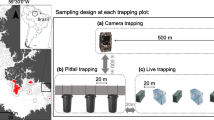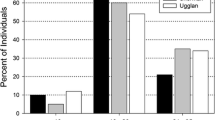Abstract
Longworth and Sherman are widely used live traps in small mammal communities in temperate and tropical areas, and their performance has been tested over decades. The Heslinga trap looks like a green colored Longworth trap, but it can be considered a technical improvement of the latter model. Due to the similar design, the Heslinga and Longworth traps are expected to have similar performance, but no study has tested the efficacy of the Heslinga trap in field conditions. In this study we compared its performance against the medium-sized Sherman trap, a widely used live trapping model recommended for small mammal sampling, in 15 small mammal stations during four consecutive years (2019–2022) and eight sampling sessions conducted twice a year (21,600 traps-night). The Heslinga trap recorded more species than the Sherman (11 versus 8), but it also recorded more captures (63% vs. 37%) and recaptures (59% vs. 41%). However, the representativeness of the species in the communities was the same when estimated by each trap model. Nonetheless, differences in detectability by trap model suggested that the occupancy of common species could be underestimated by using Sherman traps. We showed that the Heslinga trap outperformed the Sherman trap regarding species diversity estimates, capture success, and sampling inaccuracies. These results are promising, and owing to the several advantages over the Longworth trap (i.e., stronger, durable, better concealment, and cheaper), the Heslinga trap could be a serious alternative to the more widely used trap.



Similar content being viewed by others
Data availability
The datasets generated during the current study are available from the corresponding author on reasonable request.
References
Anthony NM, Ribic CA, Bautz R, Garland T Jr (2005) Comparative effectiveness of Longworth and Sherman live traps. Wildl Soc Bull 33:1018–1026. https://doi.org/10.2193/0091-7648(2005)33[1018:ceolas]2.0.co;2
Barnett A, Dutton J (1995) Expedition field techniques: small mammals (excluding bats) 2nd Edn. Royal Geographical Society with IBG 1–131
Beauvais GP, Buskirk SW (1999) Modifying estimates of sampling effort to account for sprung traps. Wildl Soc Bull 27:39–43
Boekel WHMV (2014) Damage to Longworth live-traps by shrews. Lutra 57:39–42
Boekel WHMV (2013) Reducing shrew mortality in Longworth live-traps. Lutra 56:121–127
Burger JR, Chesh AS, Castro RA, Ortiz Tolhuysen L, Torre I, Ebensperger LA, Hayes LD (2009) The influence of trap type on evaluating population structure of the semifossorial and social rodent Octodon degus. Acta Theriol (warsz) 54:311–320. https://doi.org/10.4098/j.at.0001-7051.047.2008
Caceres NC, Napoli RP, Hannibal W (2011) Differential trapping success for small mammals using pitfall and standard cage traps in a woodland savannah region of southwestern Brazil. Mammalia 75:45–52. https://doi.org/10.1515/mamm.2010.069
Chitty D, Kempson D (1949) Prebaiting small mammals and a new design of live trap. Ecology 30:536–542. https://doi.org/10.2307/1932457
Colwell RK (2012) EstimateS: Statistical estimation of species richness and shared species from samples, version 9. User's Guide and application published at: http://purl.oclc.org/estimates
Deitloff J, Falcy MR, Krenz JD, McMillan BR (2010) Correlating small mammal abundance to climatic variation over twenty years. J Mammal 91:193–199. https://doi.org/10.1644/08-mamm-a-267r.1
Diaz-Francés E, Soberón J (2005) Statistical estimation and model selection of species-accumulation functions. Conserv Biol 19:569–573. https://doi.org/10.1111/j.1523-1739.2005.00453.x
dos Santos-Filho M, da Silva DJ, Sanaiotti TM (2006) Efficiency of four trap types in sampling small mammals in forest fragments, Mato Grosso, brazil. Mastozool Neotrop 13:217–225
Eleftheriou A, Boonstra R, Luis AD (2020) Trapping deermice: effects of trap type on capture and recapture success in sagebrush habitat. Northwest Nat 101:210–215. https://doi.org/10.1898/1051-1733-101.3.210
Flowerdew JR (2004) Advances in the conservation of British mammals, 1954–2004: 50 years of progress with The Mammal Society. Mamm Rev 34:169–210. https://doi.org/10.1111/j.1365-2907.2004.00037.x
Flowerdew JR, Shore RF, Poulton SMC, Sparks TH (2004) Live trapping to monitor small mammals in Britain. Mamm Rev 34:31–50
Gorosito IL, MarzialiBermúdez M, Busch M (2018) Advantages of combining generalized linear models and occupancy models to find indicators of habitat selection: Small mammals in agroecosystems as a case study. Ecol Indic 85:1–10. https://doi.org/10.1016/j.ecolind.2017.10.003
Gotelli NJ, Colwell RK (2001) Quantifying biodiversity: procedures and pitfalls in the measurement and comparison of species richness. Ecol Lett 4:379–391. https://doi.org/10.1046/j.1461-0248.2001.00230.x
Hofmeester TR, Jansen PA, Wijnen HJ, Coipan EC, Fonville M, Prins HHT, Sprong H, Van Wieren SE (2017) Cascading effects of predator activity on tick-borne disease risk. Proc R Soc B Biol Sci 284. https://doi.org/10.1098/rspb.2017.0453
Jackson MH, Hutchison WM (1985) The effect of camouflage on the vandalism and efficiency of Longworth small mammal traps. J Zool 207:623–626. https://doi.org/10.1111/j.1469-7998.1985.tb04960.x
Jaquiéry J, Guélat J, Broquet T, Berset-Brändli L, Pellegrini E, Moresi R, Hirzel AH, Perrin N (2008) Habitat-quality effects on metapopulation dynamics in greater white-toothed shrews, Crocidura russula. Ecology 89:2777–2785. https://doi.org/10.1890/07-1833.1
Jiménez-Valverde A, Hortal J (2003) Las curvas de acumulación de especies y la necesidad de evaluar la calidad de los inventarios biológicos. Rev Ibérica Aracnol 8(151–161):1576–9518
Jung TS (2016) Comparative efficacy of Longworth, Sherman, and Ugglan live-traps for capturing small mammals in the Nearctic boreal forest. Mammal Res 61:57–64. https://doi.org/10.1007/s13364-015-0251-z
Kuznetsova A, Brockhoff PB, Christensen RHB (2017) lmerTest Package: Tests in Linear Mixed Effects Models. J Stat Softw 82:1–26. https://doi.org/10.18637/JSS.V082.I13
Lambert TD, Malcolm JR, Zimmerman BL (2005) Variation in small mammal species richness by trap height and trap type in southeastern Amazonia. J Mammal 86:982–990. https://doi.org/10.1644/1545-1542(2005)86[982:vismsr]2.0.co;2
Lambin X, MacKinnon J (1997) The relative efficiency of two commercial live-traps for small mammals. J Zool 242:400–404
Machtinger ET, Williams SC (2020) Practical guide to trapping Peromyscus leucopus (Rodentia: Cricetidae) and Peromyscus maniculatus for vector and vector-borne pathogen surveillance and ecology. J Insect Sci 20:5. https://doi.org/10.1093/jisesa/ieaa028
MacKenzie DI (2012) PRESENCE User Manual 1–78. https://www.mbrpwrc.usgs.gov/software/presence.html
Mackenzie DI, Nichols JD, Lachman GB, Droege S, Royle JA, Langtimm CA (2002) Estimating site occupancy rates when detection probabilities are less than one. Ecology 83:2248–2255
Mackenzie DL, Nichols JD, Royle JA, Pollock KH, Bailey LL, Hines JE (2018) Occupancy estimation and modeling inferring patterns and dynamics of species occurrence. Elsevier, London, UK
McCarthy A, Caravaggi A, Fernández-Bellon D, Irwin S, Lusby J, O’Halloran J (2021) Bird and small mammal community composition and abundance in upland open habitats and early conifer forests. Eur J Wildl Res 67:1–13. https://doi.org/10.1007/s10344-021-01459-5
Montgomery WI (1989) Population regulation in the wood mouse, Apodemus-sylvaticus.1. Density dependence in the annual cycle of abundance. J Anim Ecol 58:465–475. https://doi.org/10.2307/4842
Morris RD (1968) A comparison of capture success between Sherman and Longworth live traps. Can Field-Naturalist 82:84–87
Nakagawa S, Schielzeth H (2013) A general and simple method for obtaining R2 from generalized linear mixed-effects models. Methods Ecol Evol 4:133–142
Nicolas V, Colyn M (2006) Relative efficiency of three types of small mammal traps in an African rainforest. Belgian J Zool 136:107–111
O’Farrell MJ, Clark WA, Emmerson FH, Juarez SM, Kay FR, O’Farrell TM, Goodlett TY (1994) Use of a mesh live trap for small mammals: are results from Sherman live traps deceptive? J Mammal 75:692–699
Paradis E, Guédon G (1993) Demography of a mediterranean microtine: the Mediterranean pine vole, Microtus duodecimcostatus. Oecologia 95:47–53. https://doi.org/10.1007/BF00649505
Pearson DE, Ortega YK, Ruggiero LF (2003) Trap-induced mass declines in small mammals: mass as a population index. J Wildl Manage 67:684–691
RStudio Team (2020). RStudio: integrated development for R. RStudio, PBC, Boston, MA. http://www.rstudio.com/
Renwick AR, Lambin X (2011) Abundance thresholds and the underlying ecological processes: Field voles Microtus agrestis in a fragmented landscape. Agric Ecosyst Environ 144:364–369. https://doi.org/10.1016/j.agee.2011.10.006
Shonfield J, Do R, Brooks RJ, McAdam AG (2013) Reducing accidental shrew mortality associated with small-mammal livetrapping I: an inter- and intrastudy analysis. J Mammal 94:745–753. https://doi.org/10.1644/12-mamm-a-271.1
Sibbald S, Carter P, Poulton S (2006) Proposal for a national monitoring scheme for small mammals in the United Kingdom and the Republic of Eire. Mammal Soc Res Rep No 6:1–90
Sikes RS, the Animal Care and Use Committee of the American Society of Mammalogists (2016) 2016 Guidelines of the American society of mammalogists for the use of wild mammals in research and education. J Mammal 97:663–688. https://doi.org/10.1644/10-MAMM-F-355.1
Slade NA, Eifler MA, Gruenhagen NM, Davelos AL (1993) Differential effectiveness of standard and long Sherman livetraps in capturing small mammals. J Mammal 74:156–161. https://doi.org/10.2307/1381915
Stephens RB, Anderson EM (2014) Effects of trap type on small mammal richness, diversity, and mortality. Wildl Soc Bull 38:619–627. https://doi.org/10.1002/wsb.418
Torre I, Cahill S, Grajera J, Raspall A, Raspall A, Vilella M (2022) Small mammal sampling incidents related to wild boar (Sus scrofa) in natural peri–urban areas. Anim Biodivers Conserv 45:33–42. https://doi.org/10.32800/ABC.2022.45.0033
Torre I, Fernández L, Arrizabalaga A (2015) Using barn owl Tyto alba pellet analyses to monitor the distribution patterns of the yellow-necked mouse (Apodemus flavicollis Melchior 1834) in a transitional Mediterranean mountain. Mammal Study 40:133–142
Torre I, Freixas L, Arrizabalaga A, Díaz M (2016) The efficiency of two widely used commercial live-traps to develop monitoring protocols for small mammal biodiversity. Ecol Indic 66:481–487. https://doi.org/10.1016/j.ecolind.2016.02.017
Torre I, López-Baucells A, Stefanescu C, Freixas L, Flaquer C, Bartrina C, Coronado A, López-Bosch D, Mas M, Míguez S, Muñoz J, Páramo F, Puig-Montserrat X, Tuneu-Corral C, Ubach A, Arrizabalaga A (2021) Concurrent butterfly, bat and small mammal monitoring programmes using citizen science in Catalonia (NE Spain): a historical review and future directions. Diversity 13:454. https://doi.org/10.3390/D13090454
Torre I, Palau O (2023) Is shrub encroachment driving the decline of small mammal diversity in Pyrenean grasslands? Diversity 15:232. https://doi.org/10.3390/D15020232
Torre I, Raspall A, Arrizabalaga A, Díaz M (2019) Evaluating trap performance and volunteers’ experience in small mammal monitoring programs based on citizen science: the SEMICE case study. Mamm Biol 95:26–30. https://doi.org/10.1016/J.MAMBIO.2019.01.004
Torre I, Raspall A, Arrizabalaga A, Díaz M (2018) SEMICE: An unbiased and powerful monitoring protocol for small mammals in the Mediterranean Region. Mamm Biol 88:161–167. https://doi.org/10.1016/j.mambio.2017.10.009
Umetsu F, Naxara L, Pardini R (2006) Evaluating the efficiency of pitfall traps for sampling small mammals in the neotropics. J Mammal 87:757–765. https://doi.org/10.1644/05-mamm-a-285r2.1
Westra SA, Mol RR, Desjardins RB, Visser MD, Baele AVMPC, van Montfort D (2022) Results of a small terrestrial mammal survey in the remote Boé region of Guinea-Bissau, with discovery of two new shrew records for the country. Afr J Ecol 60:946–957. https://doi.org/10.1111/aje.13044
Zeileis A, Kleiber C, Jackman S (2008) Regression models for count data in R. J Stat Softw 27:1–25. https://doi.org/10.18637/jss.v027.i08
Acknowledgements
The authors thank James Evarts, Mike Lockwood, and Jordi Esquerda, for providing economic and logistic support in the study area, and Antoni Arrizabalaga (Labs’ head) for providing bureaucratic support and guarantee to the small mammal monitoring programs throughout the years. Jana Marco assisted in the field work. Tom Heslinga gave some information about the material used, date of construction, and commercialization of the Heslinga trap. Alfons Raspall kindly provided the pictures of small mammals. We also want to thank the staff of the Natural Parks where the study was performed, which provided the permits and potential location for sampling stations: Albert Vila (PN Capçaleres del Ter i Freser), Gerard Carrion and Ponç Feliu (PN del Cap de Creus), Emili Bassols (PN de la Zona Volcànica de la Garrotxa), Santi Ramos (PN del Montgrí, les Illes Medes i el Baix Ter), and Enric Bisbe (Consorci de Les Gavarres).
Funding
The research was funded by the Catalan Government (Generalitat de Catalunya, grant no. DB201804) and by James Evarts and “Apatura Iris, S.L.”
Author information
Authors and Affiliations
Contributions
IT conceived the idea and OP collected the field data; OP and IT analyzed the data; IT wrote the manuscript; OP and IT contributed critically to the drafts and gave final approval for publication.
Corresponding author
Ethics declarations
Ethics approval
This study was performed under the scientific permits: 2019–SF/554, 2020–SPM/4, and 2021–SF/41, provided by the Catalan Government.
Competing interests
The authors declare no competing interests.
Additional information
Communicated by Jan M. Wójcik.
Publisher's Note
Springer Nature remains neutral with regard to jurisdictional claims in published maps and institutional affiliations.
Rights and permissions
Springer Nature or its licensor (e.g. a society or other partner) holds exclusive rights to this article under a publishing agreement with the author(s) or other rightsholder(s); author self-archiving of the accepted manuscript version of this article is solely governed by the terms of such publishing agreement and applicable law.
About this article
Cite this article
Palau, O., Torre, I. Testing the efficacy of the Heslinga live trap for small mammal community assessments. Mamm Res 69, 23–31 (2024). https://doi.org/10.1007/s13364-023-00720-3
Received:
Accepted:
Published:
Issue Date:
DOI: https://doi.org/10.1007/s13364-023-00720-3




